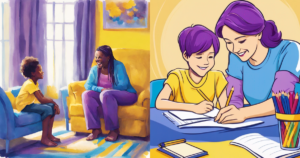When we focus solely on the behavior our child is exhibiting, we often miss the underlying pain that the behavior is trying to protect. Children, much like adults, exhibit behaviors as a response to their emotional states. However, unlike adults, they might lack the vocabulary to express what they’re truly feeling. Therefore, it is important for us as parents to notice and work to understand the emotions behind the behavior.
It is crucial as a parent to remember, our children have never been this age or stage before so, unlike us, they have no reference points. They are also under construction from head to toe. Think about it. Our children’s brain isn’t fully developed until about 25 years of age. Plus, the emotional part of their brain is approximately 2.5 times larger than the critical thinking, pre-frontal cortex, so emotions can easily hijack their rational thinking ability. And, they have hormones racing through their system – yes, a lot is happening on the inside!
Before reacting to our child’s behavior, we can take a moment to step back and consider what might be driving their actions and emotions behind the behavior? Are they feeling scared, lonely, or frustrated? Reacting impulsively or with punishment might exacerbate the situation, leading to more acting out. Instead, approach them with empathy and a desire to understand.
Our children also tend to be sensitive and empathic picking up on other’s feelings. When this happens, they (or us), can unknowingly react in a way that doesn’t necessarily make sense for the current situation. One practice is to, in an age-appropriate way, when speaking with your child about how they are feeling to ask them if they were around anyone else that might have been feeling that way. This can help them discern what is truly their feelings and what might be someone else’s.
It’s important to realize that this process requires patience and might take more than one conversation. Building a space where our child feels safe to express their true feelings can take time. Engage with them from a place of love and openness. Ask gentle, open-ended questions that encourage them to share their thoughts and feelings without fear of judgment or consequence. (To learn more, check out The Strategic C.A.L.M. Approach to Communication for parents to learn how to better understand, communicate and connect with your child)
For example, if our child throws a tantrum when it’s time to leave the park, instead of focusing on the outburst itself, consider what could be causing the emotions behind the behavior. Maybe they’re upset because they didn’t get enough time to play, or perhaps they’re worried about something that happened earlier in the day. By acknowledging their emotions, we validate their feelings and help them feel heard.
In practice, try saying something like, “I see you’re really upset about leaving the park. Can you tell me what’s wrong?” This approach not only helps in understanding the root cause of the behavior but also shows our child that their feelings are important and worthy of attention.
By focusing on the emotions behind the behavior and addressing it from a place of compassion and patience, you can foster a deeper connection with our child and help them navigate their emotions more effectively.











